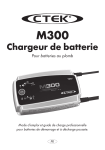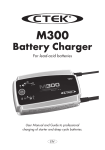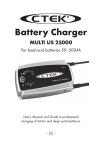Download CTEK MULTI XS 4003 1035 User`s manual
Transcript
MULTI XS 4003 Battery charger FI NO DK SE NL IT For lead-acid batteries 1.2–140Ah ES FR DE QUICK GUIDE EN ® Model 1035 User’s Manual and a guide to professional battery charging for starter/deep cycle batteries. QUICK GUIDE MULTI XS 4003 For details – see manual V A Connect the red lead to the positive pole of the battery and the black lead to the negative pole. + – When you are sure the battery leads are correctly placed, connect the charger to the wall socket. Mains voltage connected Error Battery size 1.2–14Ah A V Battery size 14–140Ah Ready to use Snowflake Battery size 14–140Ah Fully charged Recond Battery size 14–140Ah QUICK GUIDE Settings are made by pressing the “MODEbutton” and stepping forward one press at a time until the required mode is reached, the button is then released. INTRODUCTION Congratulations on purchasing your new professional switch mode battery charger. This charger is included in a series of professional chargers from CTEK SWEDEN AB and represents the latest technology in battery charging. Please read this user´s manual and follow the instructions carefully. SAFETY • The charger is designed for charging 12V lead-acid batteries. Do not use the charger for any other purpose. • Battery acid is corrosive. Rinse straight away with water if acid comes into contact with skin or eyes, and seek immediate medical advice. • Ensure that the cabling does not jam or comes into contact with hot surfaces or sharp edges. • A battery being charged could emit explosive gasses, which is why it is important to prevent sparks close to the battery. When batteries are reaching the end of their lifecycle internal sparks may occur. • Always provide for proper ventilation during charging. • Avoid covering the charger. • Ensure that the mains cable is not exposed to water. • Never charge a frozen battery. • Never charge a damaged battery. • Never place the charger on top of the battery when charging. • Connection to the mains supply must be in accordance with the national regulations for electrical installations. • Check the charger cables prior to use. Ensure that no cracks have occurred in the cables or in the bend protection. A charger with damaged cables must not be used. • Always check that the charger has switched to maintenance charging mode before leaving the charger unattended and connected for long periods. If the charger has not switched to maintenance charging within 72 hours, this is an indication of an error. In such cases the charger must be disconnected manually. • All batteries fail sooner or later. A battery that fails during charging is normally taken care of by the chargers advanced control, but some rare errors in the battery could still exist. Don’t leave any battery unattended for a longer period of time. • This appliance is not designed for use by young children or people who cannot read or understand the manual unless they are under the supervision of a responsible person to ensure that they can use the battery charger safely. Store and use the battery charger out of the reach of children, and ensure that children cannot play with the charger. • Batteries consume water during use and charging. For batteries where water can be added, the water level should be checked regularly. If the water level is low add distilled water. 4 BATTERY TYPES AND SETTINGS EN The MULTI XS 4003 model offer several alternative settings to suit specific charging needs and required functionality. The following recommendations should only be regarded as guidelines. Please observe the battery manufacturer recommendations in the event of uncertainty. Settings are made by pressing the “MODE-button” and stepping forward one press at a time until the required mode is reached, the button is then released. After about two seconds the charger activates the selected mode. The selected mode setting will be restored next time the charger is connected. The table explains the different modes: Mode RECOND Battery size (Ah) Explanation 1.2–14 Mode 14.4V/0.8A This mode shall be used for batteries smaller than 14Ah. 14–140 Mode 14.4V/4A Normal mode for wet batteries, MF and for most GEL batteries. 14–140 Mode 14.7V/4A This mode is recommended for charging batteries at temperatures lower than +5°C. It is also recommended for many AGM batteries. This setting is not recommended for maintenance charging when the temperature temporarily exceeds +5°C. Here we recommend the 14.4V/4A or 14.4V/0.8A mode. 14–140 This mode is used to recover deeply discharged batteries where you could expect a stratified acid (high acid weight in the bottom, low on top). This problem arises primarily in open vented batteries, i.e. not Gel and AGM. Use this step with care, because the high voltage may cause some water loss in the battery. Contact the battery supplier if you are uncertain. 15.8V is normally no problem for electronics in 12V systems but consult your supplier when in doubt. The service life of lamps drops at higher voltages. Maximum effect and minimum risk for electronics is achieved by charging a disconnected battery in this step. 5 The table explains the various lamps: Mains voltage connected. If the mode is incorrect, the charger cuts the charging/voltage supply. The charger switches to error mode before starting in the following circumstances: If the battery has been connected with reverse polarity to the charger terminals. The charger’s analysis function has interrupted the charge. The charger has been in start mode for a time that exceeds max time. Where possible, correct the cause of the fault and start the charge by pressing the “MODE” or “RESET” button. The charger restarts in the mode that was last used. 1 Desulphation 2 Soft Start Charge acceptance check 3 Bulk Charge 4 Absorption Charge 5 Analysis 6 Recond 7 Maintenance Charge – Float 8 Maintenance Charge – Pulse CHARGING Connection of the charger to batteries that are fitted in vehicles: 1. The mains cable should not be connected to the wall socket when connecting or disconnecting the battery leads. 2.Identify the pole that is earthed (connected to chassis). Earth is normally connected to the negative terminal. 3.Charging of negatively earthed battery: Connect the red lead to the positive pole of the battery and the black lead to the vehicle chassis. Be careful not to connect the black lead close to the fuel pipe or the battery. 4.Charging of positively earthed battery: Connect the black lead to the negative pole of the battery and the red lead to the vehicle chassis. Be careful not to connect the red lead close to the fuel pipe or the battery. Connection of the charger to batteries that are not fitted in vehicles: 1. The mains cable should not be connected to the wall socket when connecting or disconnecting the battery leads. 2.Connect the red lead to the positive pole of the battery and the black lead to the negative pole. 6 If the battery leads are incorrectly connected, the reverse polarity protection will ensure that the battery and charger are not damaged. EN Start charging 1. When you are sure the battery leads are correctly placed, connect the charger to the wall socket. The charger will indicate that the mains voltage is connected. If the battery leads are incorrectly connected, the reverse polarity protection will ensure that the battery and charger are not damaged. The fault indicator lamp will be lit. If this is the case start from section 1 again “Connection of charger...”. 2.In order to start charging the correct current and voltage must be set by pressing the “MODE” button until the proper setting is lit. Selecting the setting for your battery is described in “BATTERY TYPES AND SETTINGS”. 3.The lamp for deeply discharged battery will indicate if the battery voltage is low (see Min battery voltage in “TECHNICAL SPECIFICATIONS”). 4.Normal charging will be indicated by the lamps for soft start (deeply discharged battery) bulk charge, absorption charge or maintenance charge. When the lamp for maintenance charge is lit this means that the battery is fully charged. The charge will restart again if the voltage drops. Indications for Recond and Snowflake modes are described in “BATTERY TYPES AND SETTINGS”. 5.If the lamp that indicates settings and the power lamp remains lit but no other lamp is lit, there could be a bad connection to the battery or chassis or the battery could be defect or have a terminal voltage that is too low. The charger requires that the battery voltage is above a certain level, see “TECHNICAL SPECIFICATIONS” to start the charging cycle. This means that if the battery is in a state of deep discharge the charger will be unable to charge the battery in question. Another reason could be lack of power from the wall socket. Start by improving the connection between the battery and the charger. 6.Charging can be stopped at any time by disconnecting the mains cable from the wall socket. Always disconnect the mains cable from the wall socket before disconnecting the battery leads. When you interrupt charging of a battery installed in a vehicle, you must always disconnect the battery lead from the chassis before disconnecting the other battery lead. CHARGING STEPS All battery chargers charge and analyse in eight fully-automatic steps. The MULTI XS 4003 model has many different settings, see “BATTERY TYPES AND SETTINGS”. The battery chargers have an 8 step fully-automatic charging cycle: Desulphation Desulphation with pulses restores sulphated batteries. This is indicated with a fixed beam during this step. Soft start Starting mode for charging cycle. The start step continues until the battery terminal voltage has risen above the set value, at which time the charging switches to bulk charge. If the terminal voltage has not reached the set level within a set time, the charge is stopped and the charger indicates error mode. The battery is then probably defective or too large. Bulk Main charge until 80% of the charge is complete. The charge is carried out at maximum current charge until the terminal voltage reaches the set level. Bulk charging has a maximum time. The charging then switches to Absorption. Absorption Final part of the charge up to 100%. During this step the charge current falls gradually to ensure the terminal voltage does not get too high. If the maximum time for Absorption is exceeded, the charger switches automatically to maintenance. 7 Analysis Tests the self-discharge. If the self discharge is too high, the charging is interrupted and error mode indicated. Recond Reconditioning of deeply discharged batteries. This step is used to restore deeply discharged open vented batteries. With increased charging voltage over a limited time, the voltage is allowed to rise so that the battery starts to emit gas. As a result you get a mix in the battery that is good both for its capacity and service life. Note that the battery may emit explosive gases during this step. Recond takes place between the analysis and maintenance steps. When choosing the Recond-mode, the charger will first charge your battery up to full-charged. When this is done the charger will start the Recond and the upper Recond-lamp will lit. The charger reconditions the battery between 30 min and 4 hours depending on the need of the battery. Once the recond is done, the charger will switch into maintenance-mode (green light for fully charged). The bottom Recond-lamp will still be on as a reminder that you have chosen the Recond. Maintenance charge – Float Charging with constant voltage. Maintenance charge – Pulse The state of charge varies between 95% and 100%. The battery receives a pulse when the voltage has dropped to a predefined level. This keeps the battery in trim when not in use. The charger could be connected for months at a time. Check the water level in the battery if possible. The charger measures the terminal voltage continuously to determine whether a charge pulse should be started. If the battery is loaded and/or the terminal voltage drops, the charger starts a charge pulse so that the terminal voltage rises to the set level. The charge pulse is then finished and the cycle is restarted. If the terminal voltage drops even lower, the charger automatically reverts to the beginning of the charge cycle. CHARGING TIME The table below shows the estimated time for bulk charging. Battery size (Ah) Time to ~80% charge (h) 2 2 8 8 20 4 60 12 140 28 TEMPERATURE PROTECTION The chargers are protected against overheating. The power reduces when the ambient temperature increases. The charger may be perceived as being hot during charging. This is completely normal, although you should avoid placing it on a sensitive surface. 8 The charger is maintenance free. Please note that dismantling the charger is not permitted and will void the warranty. A defective mains cable has to be replaced by CTEK or by a representative authorised by CTEK. Keep your charger clean. Wipe it with a soft tissue and mild cleaning liquid. The charger must be disconnected for cleaning. EN MAINTENANCE EQUIPMENT The MULTI XS 4003 model is delivered with one battery lead with battery clamps and one battery lead with eyelet terminals. TECHNICAL SPECIFICATIONS Charger model Model number Rated Voltage AC Charging voltage Min battery voltage Charging current Current, mains Back current drain* Ripple** Ambient temperature Cooling MULTI XS 4003 1035 220–240VAC, 50–60Hz Car/Motorcycle 14.4V, 14.7V, RECOND 15.8V 2.0V 4A max 1.2A rms (at full charging current) <1Ah/month Max 240mVp-p and 160mA p-p -20°C to +50°C, output power is reduced automatically at high temperatures Natural convection Charger type Eight step, fully automatic charging cycle Battery types All types of 12V lead-acid batteries (WET, MF, AGM and GEL) Battery capacity Dimensions Insulation class Weight 1.2–140Ah 168 x 65 x 38 mm (L x W x H) IP65*** 0.6kg *) Back current drain is the current that drains the battery if the charger is not connected to the mains. CTEK chargers has a very low back current. **) The quality of the charging voltage and charging current is very important. A high current ripple heats up the battery which has an aging effect on the positive electrode. High voltage ripple could harm other equipment that is connected to the battery. CTEK battery chargers produce very clean voltage and current with low ripple. ***) If connection to the mains is by the flat Euro connector, the battery charger has the IP63 insulation class apart from in Switzerland where IP65 applies. 9 PROGRAM DESCRIPTION Soft start Bulk Absorption Revives a sulphated battery Tests the state of the battery Main charge Top charge and minimal fluid loss Current (A) Voltage (V) Desulphation 10 YES 4A for max 8h until the voltage reaches 12.6V. 4A for max 20h. A combination of current limits and timers, max 10h. YES 0.8A for max 8h until the voltage reaches 12.6V. 0.8A for max 20h. A combination of current limits and timers, max 10h. Recond Float Pulse Tests whether the battery can retain energy Reconditioning of deep discharged batteries Maintenance for maximum performance Maintenance for maximum service life Alerts the user if the voltage drops to 12V in 3 minutes. Max 15.8V and 1.5A for 4h for deep discharged batteries. Otherwise for 30 minutes (only in RECOND mode). Alerts the user if the voltage drops to 12V in 3 minutes. 13.6V with max 4A for max 10 days. EN Analysis Pulse starts at 12.9V, max voltage 14.4V. 13.6V with max 0.8A for Pulse starts at 12.9V, max 10 days. max voltage 14.4V. Note: In snowflake mode, MULTI XS 4003 follows the same program as CAR but with a higher voltage (14.7V). The product is protected by the following: Designs RCD 000509617 US D571179 US D575225 US D581356 US D580853 RCD 321216 RCD 200830199948X pending RCD 000911839 RCD 081418 Trade marks CTM TMA669987 CTM 844303 CTM 372715 EP1716626 pending SE526631 US-2006-0009160-A1 pending EP1903658 pending EP1483818 US2005-0225300-A1 pending US D29/319135 pending RCD 001119911 RCD 321197 RCD 321198 RCD 200830120183.6 pending RCD 200830120184.4 pending RCD 000835541 US D596125 US D596126 CTM 3151800 CTM 2009/04811 pending 2009-10-21 Patents EP1618643 SE525604 US7541778B2 EP1744432 pending EP1483817 pending SE524203 US7005832B2 11 LIMITED WARRANTY CTEK SWEDEN AB, Rostugnsv. 3, SE-776 70 VIKMANSHYTTAN, SWEDEN issues this limited warranty to the original purchaser of this product. This limited warranty is not transferable. The warranty applies to manufacturing faults and material defects for 5 years from the date of purchase. The customer must return the product together with the receipt of purchase to the point of purchase. This warranty is void if the battery charger has been opened, handled carelessly or repaired by anyone other than CTEK SWEDEN AB or its authorised representatives. One of the screw holes in the bottom of the charger is sealed. Removing or damaging the seal will void the warranty. CTEK SWEDEN AB makes no warranty other than this limited warranty and is not liable for any other costs other than those mentioned above, i.e. no consequential damages. Moreover, CTEK SWEDEN AB is not obligated to any other warranty other than this warranty. DECLARATION OF COMPLIANCE CTEK SWEDEN AB, Rostugnsvägen 3, SE-776 70 VIKMANSHYTTAN, SWEDEN. Hereby declares under sole responsibility that the MULTI XS 4003 battery charger, to which this declaration relates, conform with the following LVD standards: EN60335-1, EN60335-2-29 observing the provisions of directive 2006/95/EC. This product also conforms with the following EMC standards: EN55011, EN 61000-3-3, EN 61000-3-2, EN 55014-1 and EN 55014-2 observing the provisions of directive 2004/108/EC. The battery chargers conform with the requirements in EN 50366:2003. The chargers are available in a range of models with different mains cables. The charger with the flat Euro connector is designed for Switzerland. VIKMANSHYTTAN, SWEDEN 2009-10-01 Jarl Uggla, President CTEK SWEDEN AB, Rostugnsvägen 3 SE-776 70 VIKMANSHYTTAN, SWEDEN Fax: +46 225 351 95 www.ctek.com 12





















